






















UP TO 22% BETTER ENERGY EFFICIENCY 26% LOWER PROFILE FRAME FOR EXPANDED VIEWS
DURABLE VINYL AND HYBRID RESISTS WEATHER AND DAMAGE
AVAILABLE IN PREMIUM FINISHIELD TM LAMINATE COLOURS
Welcome in the beauty and brightness of spring with JELD-WEN®’s JWC8500 series window. This innovative window offers exceptional energy efficiency, a low-profile design and remarkably robust frame. This intentional engineering gives you cool, comfortable, and quiet interior spaces, expansive views and long-lasting performance.
Experience the world in a whole new way this spring with JELD-WEN ®’s
JWC8500 series window


Available in a tall 7" Plank and extra-wide 12" Board & Batten for greater design options.
Strong, lightweight construction is easier and quicker to install than fibre cement; no skilled labour, special tools or respirators needed.
Ensures lower expansion and greater structural integrity.
No sealing, touching up, joint flashing or caulking.



The Carrot and the Stick
Are building-faster funds really working?


P33
No Man's Land
It can be the most costly part of building, but are there any answers?
P41 Target Practice
Every generation has its own hook. Here's how to market to each one.




9 Association News
The facts and fiction of development charges, three areas where OHBA is making inroads, new energy initiatives that promise to help builders, and why it pays to be a member.
17 Inside Storey
How insurance benefits play a crucial role in employee retention and recruitment.
21 Trending
From tighter wall assemblies to the reinvention of home heating, here's what’s new in industry products and services.
49 Building Buzz
The 'More Big Cities' solution, an unpredictable market outlook, Daniels to share its accessibility program, and more news.
55 Product Focus
Touchless elevators, facial recognition and door locks that sense your arrival are among the latest suite of security measures to protect your clients.
62 Chapter Spotlight Haliburton County HBA and CEO Aggie Tose are planting the seeds for future industry members.

ON THE COVER
What sort of marketing appeals to each generation? Four industry experts share their insights.
The

Explore a handful of our most established products. The Legacy Collection features natural shades and diverse colour palettes. Combine these products to give your project the memorable charm you have been searching for.
MASONRY + LANDSCAPE Scan or click to learn more.

of
Early Spring 2025| Vol. 41 Issue 2
EDITOR
Ted McIntyre ted@laureloak.ca
ART DIRECTOR
Ian Sullivan Cant
CONTRIBUTORS
Tracy Hanes, Onah Jung
ADVERTISING
Cindy Kaye, ext. 232 cindy@laureloak.ca
PUBLISHER
Sheryl Humphreys, ext. 245 sheryl@laureloak.ca
PRESIDENT
Wayne Narciso
PUBLISHED BY
Laurel Oak Marketing Ltd. laureloak.ca
ohba.ca

Take a photo of our QR code and sign up for digital updates and news!
Ontario Home Builder is published six times per year (Winter, Early Spring, Late Spring, Summer, Fall, Awards).
Al l r ights reserved. No part of this magazine may be reproduced without the written consent of the publisher. © 2025
For address corrections please email info@laureloak.ca or phone: (905) 333-9432, ext. 245.
Si ngle copy price is $6.00
Subscription Rates:
Canada $14.95 + HST per year, USA $29.95 USD Order online at https://www.laureloak.ca/subscribe
CA NADIAN PUBLICATION MAIL AGREEMENT NO. 42011539 ISSN No. 1182-1345





OHBA has already made inroads on its three priorities—and more!
After months of planning and preparation, OHBA is ready to roll out its new growth plan! With our newly expanded team in place and a clear mandate from our members and board of directors, we’re gearing up to take on the biggest challenges facing the residential construction industry today.
We need more new homes in this province and we’re ready to make that dream a reality for Ontarians. To do so, we’re focusing on key areas of housing policy and engaging with government stakeholders to push for change for the residential construction industry.
Our top three priorities for this year are addressing industry-crushing government fees and taxes that slow down new-home construction and inflate the cost of housing, pushing for more investment for housing-supportive infrastructure, and eliminating unnecessary delays in the permitting process for new housing developments.

SCOTT ANDISON CEO, ONTARIO HOME BUILDERS' ASSOCIATION
These three areas are crucial to getting more homes built and combatting the housing crisis in Ontario.
Our new government relations team, led by Kirstin Jensen, has been working across the board with the provincial government to move these files forward and advocate for real solutions. The team works continuously on government submissions, industry consultations, developing new and existing relationships with key decision-makers, research and more.
Leveraging research and data will play a central role in our advocacy plan for 2025. For example, our latest publication, co-championed between OHBA and BILD, does a deep dive into our broken development charges system and highlights a number of practical, achievable solutions that address the issue of housing affordability. The State of DCs in Ontario, developed by Keleher Planning + Economic Consulting (KPEC),
is a straightforward evaluation of how Ontario’s development charges legislation needs to be overhauled so it is more aligned with our current economy and housing environment.
In terms of OHBA’s effectiveness, we have had several advocacy wins in the three areas mentioned above in recent months. In September, the provincial government announced a formal consultation on the implementation of surety bonds as a substitute for letters of credit. OHBA advocated for years for this alternative financial security as an option to help builders unlock capital for new housing projects, while still providing municipalities with the level of assurance they need. We were so pleased to see the government move forward on their commitment to modernize how new housing approvals are administered with this change, which will come into effect in December. We’ve also started to have conversations with municipalities about implementation.
Another example is the commitment made by Pierre Poilievre and the Conservative Party of Canada to cut GST on all homes under $1 million. This is another file OHBA has long advocated for, seeing how successful HST cuts have been in incentivizing purpose-built rental housing developments. Our ambition is for this to go further and have the commitment lead to provincial sales tax cuts for homes at a threshold beyond $1 million—representing the kind of change that would really move the needle on affordability in the province. This type of change would be precisely what we need to see in the industry when it comes to reducing the tax burden on builders and homeowners that impedes the growth of housing supply. Reductions of fees and taxes like HST, along with other fees like development charges, as we’ve seen from municipalities such as Vaughn and Mississauga, will help get more homes built in this province.
And in October, the Ministry of Energy and Electrification introduced the Affordable Energy Act, with the aim
When you become a member of your local home builders’ association you are automatically enrolled in the Ontario Home Builders’ Association (OHBA) and the Canadian Home Builders’ Association (CHBA), setting your business up for success.
WIth over 9,000 members across Canada, CHBA leads advocacy for the industry at the federal level, ensuring it retains a central role in Canada’s economy. CHBA provides vital data and resources fostering a national network that will keep you competitive and connected across Canada. 1 2 3
Join one of Ontario’s 28 local home builders’ association (HBAs) to connect with your community and grow your business.
Local HBA’s provide local advocacy support, networking opportunities, and recognition programs to help you succeed while making an impact in your community.
of facilitating electrical grid connections for new homes by removing regulatory barriers that slow their construction, ultimately aiming to make it more cost-effective. BILD played a central role in this initiative, advocating for improvements in the way new communities are electrified, and we are very proud to see this legislation move forward. Paula Tenuta and I also spoke at the Standing Committee on the Interior in November, where we voiced our support for the legislation. This was a great step towards developing the infrastructure needed to support new homes across the province and a great indicator of the direction the Ministry of Energy and Electrification is going.
In addition to our advocacy efforts, we’re also focused on delivering a number of initiatives to our members in 2025. We’re hosting more events, both virtual and online, with an eye on education, training and building connections. This includes a series of webinars focused on training for our renovator members, continuing with our series of regional housing summits, and working with ENERQUALITY and other partners
OHBA supports over 4,000 members through provincial advocacy and industry resources. OHBA amplifies your voice to key stakeholders, provides education and training opportunities, and connects you to industry leaders province-wide, ensuring you thrive in Ontario’s housing sector.
to expand our current educational offerings. As was announced at our 2024 Annual Conference, ENERQUALITY will be a central component of our education and training plans, aimed at developing skills the industry has expressed a need for, including in the realm of energy efficiency. We’re also hosting exclusive new events such as an annual golf tournament, while expanding our housing tour program this year to include a local destination to help our members connect, learn best practices and gain insights on the latest housing developments.
In addition to more member events, we’re introducing key technology changes that will help drive OHBA forward. We’re updating our association management system by implementing iMIS, which will allow us to more efficiently manage information, communicate with and support our members, as well as coordinate with our 28 local chapter associations. iMIS is currently the most popular integrated cloud-based solution supporting associations and charities across North America. We expect its implementation to significantly
improve how we share information with members, allowing our team to keep members abreast of critical updates and data for the housing industry.
Beyond everything we’re delivering for existing members, we’re also looking to drive new membership growth in key areas. One subset of that membership is renovators, who represent a vital component of the residential construction industry—both in terms of employment and investment. A lot of our advocacy, events and training efforts will be focused on supporting the professional renovation sector, which continues to grow despite the challenges it faces.
Ultimately, there has never been a more exciting time to be a part of OHBA, and I’m very much looking forward to what’s to come. I’m also very grateful to my team, which has done a remarkable job of coming together and championing the new vision for OHBA.
I’m confident that together we will be able to move the industry forward, build more homes and continue to act as the voice of the residential construction industry. OHB
FOR ONE HOME OR FOR MANY, THINK GOEMANS FOR YOUR NEXT APPLIANCE PROJECT.




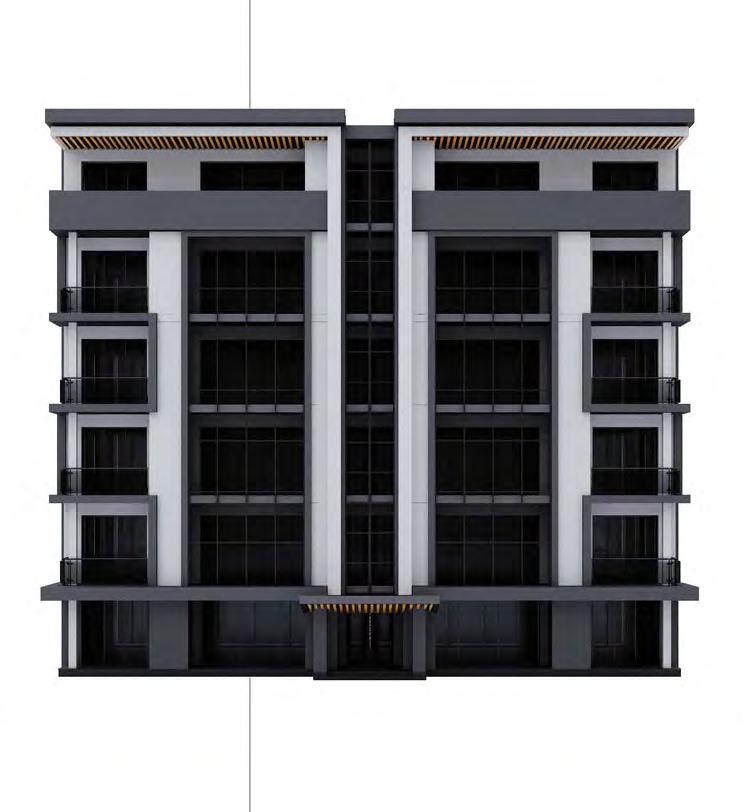



Whether big or small, choosing Goemans for your project is sure to put time back in your day. Our responsive team will be there every step of the way from qualifying your needs, to dealing with your clients, to facilitating a smooth onsite delivery and quickly correcting issues. Do appliances right with Goemans and scan the code to connect with an experienced Commercial Account Manager.

The Ministry of Energy and Electrification has been on a bit of a streak when it comes to new legislation and investments to support growth in Ontario. Two recent moves made by Minister Stephen Lecce are expected to benefit the residential construction industry and, in turn, new and existing homeowners.
First, the minister introduced new legislation in the Affordable Energy Act. The province’s firstever integrated energy plan, it includes a key component for increasing housing supply in Ontario, facilitating last-mile grid connections for new housing. The legislation would provide government with new regulation-making authority aiming to ensure more timely and cost-effective electrical grid connections. The idea is to expedite approvals required for new grid connections and to reduce the costs of making them happen,
both of which would reduce costs for builders and, therefore, new homeowners as well.
This was a great step forward for the industry, as housing-supportive infrastructure is one of the essential elements to building more homes in the province and one of OHBA’s key advocacy priorities.
Second came the ministry’s announcement of $10.9 billion in funding over 12 years for energy efficiency programs, including the new Home Renovation Savings Program that launched at the end of January. The renovation sector in Ontario is responsible for hundreds of thousands of jobs and contributes over $25 billion in wages and $50 billion in investment to Ontario’s economy. The Home Renovation Savings Program should help save homeowners thousands by offering rebates of up to 30% on projects including new windows and doors, insulation,
air sealing, smart thermostats, heat pumps and more, encouraging homeowners to pursue these renovations and improvements. In turn, this should result in increased activity for renovators contracted by homeowners to take on projects that fall under these rebates. With the challenges that the professional renovation sector has faced in recent years, initiatives like this are key to supporting an industry that is central to the province’s economy.
Ultimately, both programs point to a fundamental understanding of how interlinked the energy and housing sectors are and their importance to Ontario’s economy. If we are to successfully bring an end to the housing crisis in Ontario, it is essential to support the diverse needs of the residential construction industry, including the infrastructure needed to build new homes. OHB

















We recognize the important work done by builders and developers across Ontario. We strive to be your energy provider of choice and are committed to ensuring that Enbridge Gas adds value to every builder’s experience. The Savings by Design program promotes best practices, innovation, energy-e ciency programs and training opportunities to support the building of higher performance homes.
Connect with your regional representative today to get started. Visit enbridgegas.com/savingsbydesign to learn more.


FI TION: “Development charges and other government fees and taxes do not impact housing affordability.”
FA T: Government fees and taxes, which are mostly development charges, contribute to approximately 30% of the cost of a new home.
FI TION: “Only developers pay development charges.”
FA T: Development charges are costs passed on to potential homebuyers, often adding hundreds of thousands of dollars to the final cost of a new home, contributing materially to the rising cost of housing across the province.
FI TION: “Everyone in the community benefits from development charges.”
FA T: Development charges often go towards infrastructure that new homeowners who pay for them do not benefit from. (For example, a new park on the other side of town or maintenance of an existing cemetery.)
FI TION: “The development charge rate for a single unit never exceeds $100,000.”
FA T: In some municipalities, development charges exceed $200,000 per unit.
FI TION: “Municipalities need to continually raise development charges to be able to afford infrastructure development.”
FA T: Municipalities have billions of dollars in development charge reserves that go unspent yearto-year. Moreover, they can fund infrastructure and acquire land without relying on development charges.
FI TION: “Municipal governments have not raised development charges during the provincial housing crisis.”
FA T: Development charges have gone up an average of $42,000 for low-rise developments and $32,000 per unit for high-rise developments since 2022 alone!
FI TION: “Municipal governments ensure development charge increases are reasonable.”
FA T: Development charges increased an average of 327% in the Greater Toronto Area since 2009, when the Great Recession upended the global housing market.
FI TION: “Development charges and their use is strictly regulated.”
FA T: Instead of spending development charges, municipalities can simply allocate them toward future projects, according to the Development ChargesAct. Municipalities regularly do this, allowing them to keep billions in reserves. Moreover, municipalities have no limits when it comes to raising development charges annually and have the discretion to value their own assets (i.e., land) used as the basis for calculating development charges.
FI TION: “Municipalities are incentivized to use land efficiently.”
FA T: Municipalities inflate land value to collect more development charges. Land value inflation has resulted in $3.5 billion to $7 billion in development charges overcollection, directly affecting the cost of housing.
FI TION: “Developers are against all development charges.”
FA T: Developers are against the unpredictability of development charges and development charges being used to inflate land value in municipalities.


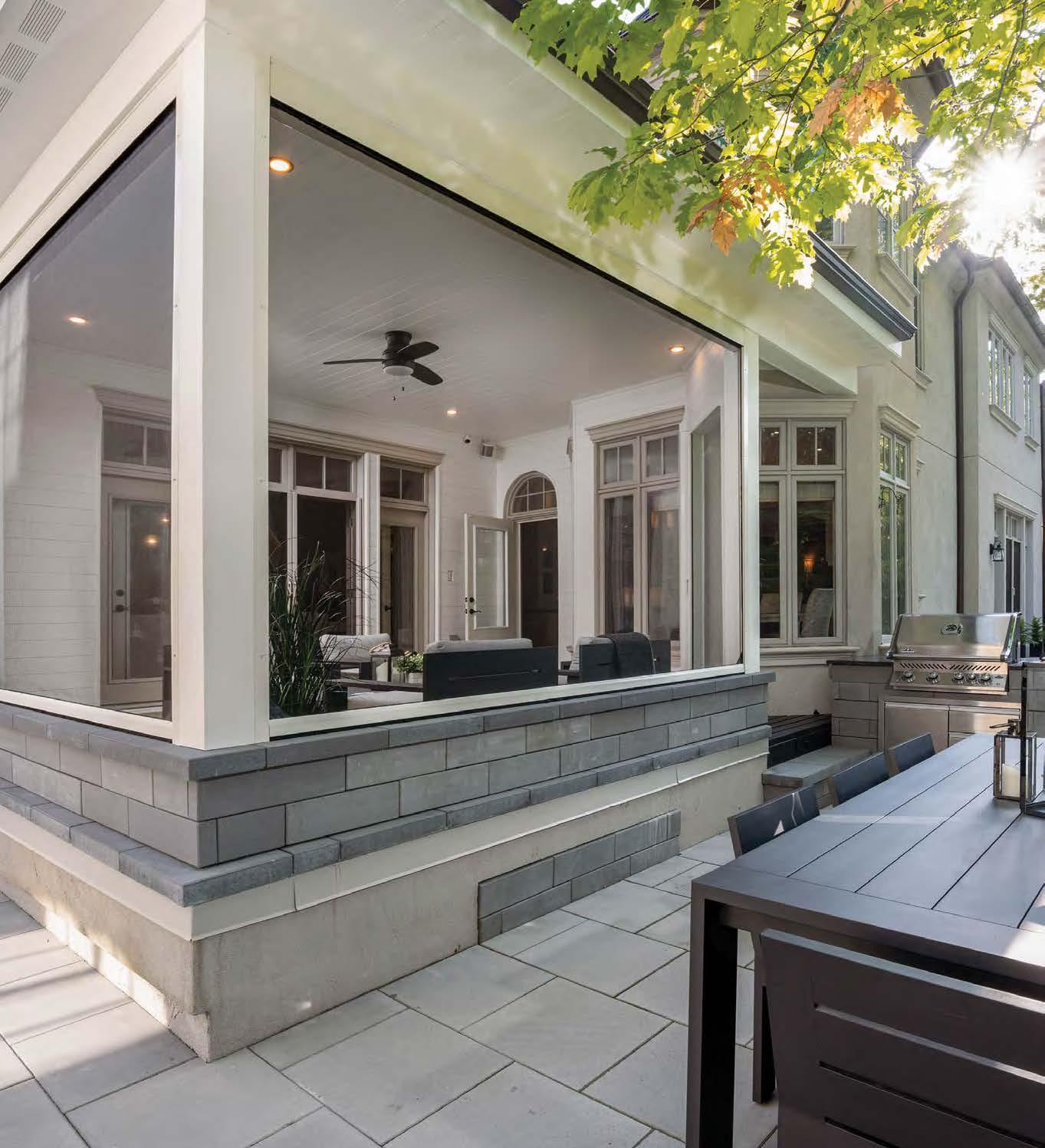


By Ted McIntyre with Michael Kelly, President, Blueprint Insurance Services
BENEFITS CANADA reports that 80% of Canadian employees consider an employer’s health benefits before accepting a new role. In fact, in a 2021 survey by Glassdoor examining the top factors that jobseekers look for in job ads, salary was atop the list at 67%, but benefits were close behind at 63%.

MICHAEL KELLY PRESIDENT, BLUEPRINT INSURANCE SERVICES
As president of Blueprint Insurance Services, Michael Kelly appreciates the importance such benefits play in recruitment and retention—especially in the residential construction industry. Kelly inherited a longstanding relationship with OHBA when Blueprint acquired Mainway Insurance in 2015,
and he has nurtured it since. “We took on all members and their history at that time, and we have continued to grow that relationship—from sponsorships and supporting membership drives of local chapters to serving as a valuable resource to the association for all their benefits needs,” Kelly says.
But these are trickier waters than ever to navigate, with skyrocketing drug prices and a virtual mental health epidemic.
OHB: Are many companies cutting back on employee benefits in these tight economic times?
MK: “Not many. A benefits plan is a very viable way of making sure your staff get the help they need to stay healthy, focused and on the job. According to the GreenShield 2024 Health Outcome Report, the cost of absenteeism to the Canadian economy exceeds $16 billion. So it’s not just about enhancing employee wellbeing but also contributing to a more productive and loyal workforce. Trying to save money by taking benefits away from your employees almost always costs you more in the long run.
“A good benefits package is a way of attracting and retaining skilled workers in an industry facing increasing shortages of skilled labour. It reduces turnover rates and ensures project continuity. And employees who feel valued through comprehensive benefits are generally more satisfied with their jobs. Higher job satisfaction leads to increased motivation and better performance.”
Unfortunately, those benefits costs for companies have been increasing. What’s contributing to the rise?
“The 2024 GreenShield Drug Trends report reveals that GLP-1 agonist drugs led to a 50% increase in expenses for this drug category between 2022 and 2023. This class of GLP-1 anti-obesity and diabetic drugs—such as Ozempic, Mounjaro, Rybelsus and Wegovy—are becoming increasingly popular due to widespread marketing and social media promotion. This surge in popularity has significantly boosted the demand



for these medications. These are costly drugs. The more they become available to employees, the greater the onus on plan sponsors to include those drugs in their plans. And the reality is, when you continue to add these high-cost drugs to your plan and don’t control how or why they’re being claimed, you’re only going to see your healthcare costs continue to go through the roof. It’s why we’re trying to convey a level of education to our clients to say, ‘Hey, maybe you don’t need to have the most expensive drug available to your employees right out of the gate.’ Maybe it’s a stepped process where you say, ‘If they have to get to that drug, fine, but let’s make sure there are some parameters in place before we get there.’ We absolutely want employees to get the medication they need. But it’s also really important for them to understand where the cost of their employee benefits program comes from.”
Are the growing demands and increasing costs fostering the need for innovation in your industry?
High-quality construction done faster and more affordably—without compromising on strength or precision.


“Yes. It’s calling for many to think outside the box. There is a clear need to incorporate preventative measures to help identify and address potential issues before they escalate. For example, last fall, we expanded the OHBA Group Benefits Plan to include a wide range of value-added services that go beyond traditional benefits. These services provide additional support for your employees’ overall well-being, such as one-on-one nutritional health coaching, a self-help program offering online courses to promote a healthy and balanced lifestyle, and pharmacogenetic testing to validate your medication and virtual health care, to name a few. Unlike regular benefits, which cover specific medical or financial needs, these services focus on preventative care and lifestyle improvements, helping your employees stay healthy and productive in the long term. We’re providing the plan sponsors with a way to help address, mitigate or hopefully entirely prevent issues from arising with their employees.”
There has been a rise in mental health concerns since the pandemic. How has this impacted the benefits landscape?
“The number of plan members making mental health practitioner claims
grew by almost 70% between 2019 and 2022, according to the Sun Life 2023 Claiming Trends report.
“Meanwhile, due to limited access, claims for paramedical services such as massage therapy, chiropractic care and physiotherapy decreased during the pandemic. While claims for most of those practitioners remain lower than their pre-pandemic levels, claims for mental health practitioners have continued to increase—almost 150% since 2019, according to Sun Life!
“Further, GreenShield has reported that one-third of employees would leave their current position in search of better mental health benefits! This highlights a critical need for robust mental health resources and reminds us that employers, especially in highstress industries like building, have to prioritize mental health support as part of their benefits offerings.”
Are those statistics being factored into today’s benefits packages?
“Absolutely. The insurance industry and plan sponsors are recognizing and responding to that trend. One effective approach is expanding coverage to include a broader range of mental health practitioners. Instead of limiting coverage to just psychologists, I would suggest adding psychotherapists and social workers, which provides employees with a wider variety of options to find the proper support.
“Additionally, some organizations are going a step further by offering extra mental health resources. For example, the OHBA benefit plan gives members access to a mental health resource centre called People Connect. This platform is specifically designed to tackle mental health challenges by providing an online hub filled with valuable resources and tools for both organizations and their employees.
“Providing these additional resources is incredibly important, especially considering 2.5 million Canadians report being unable to access the mental health care they need, according to the Canadian Mental Health Association By offering a variety of options and supportive resources, companies can better address their employees’ mental health needs and foster a healthier, more productive workforce.”
Exterior above grade SilveRboard® Graphite
Taped to act as a “second plane of protection” and provide continuous insulation

Exterior below grade SilveRboard® Mantains continuous insulation
Roof/ceiling SilveRboard®
Taped & sealed to act as a vapor barrier
Interior below grade SilveRboard® Graphite
Decouple wood stud wall from concrete
Underslab SilveRboard®
Taped and sealed to act as a vapor barrier



Trending tones and designs from Vintage Flooring. P.22

Launched last summer, Alleguard’s AmBuck helps provide tighter, more efficient wall assemblies. The insulated window and door block-out system features stay-in-place buck formwork manufactured using Type 2 closed-cell EPS panels for ICF walls. Eliminating the need for wood and vinyl block-outs, the AmBuck system offers a cost-effective and energyefficient solution while also reducing construction time thanks to its fast and easy assembly. In the long term, it prevents warping, cupping, bowing and splitting seen in most conventional woodbased block-out systems. ALLEGUARD.COM

Rinox is enhancing curb appeal with its new Macchiato stone colour for home exteriors. Featuring an elegant blend of soft beige and rich brown latte undertones, Macchiato creates a warm, inviting facade that will complement a wide range of architectural styles, from modern to traditional, while adding a touch of sophistication. RINOX.COM

Up to 53% lighter and 40% smaller than a cube-style unit, the Goodman SD system combines ductless-style technology with traditional ducted systems. Featuring a slim side-discharge design requiring only four inches of clearance, it includes a high-performing inverter compressor for quiet efficiency, achieving up to 17.5 SEER2 and 8.6 HSPF2. Featuring new R32 refrigerant models in 1.5- to 5-ton sizes, the SD integrates with Goodman brand gas furnaces and air handlers for versatile applications, all managed by the Goodman GTST thermostat for tailored indoor comfort. GOODMANMFG.COM
Navien’s NPF highefficiency hydro-furnaces boast a unique hydronic forced-air heat exchanger design that keeps combustion in a separate compartment outside of the heating air stream for quieter operation. By exposing the air to much lower temperatures, there is less impact on the conditioned air humidity level, providing consistent comfort while minimizing energy consumption. Featuring 97% AFUE, it uses standard gas lines and ductwork, making it a smart, comfortable replacement for traditional forced-air furnaces. NAVIENINC.CA

Colours continue to trend to ‘Caramilk’ tones, suggests Ontario’s Vintage Flooring. Catering to that increasing demand, Vintage has launched White Oak Thatch, Maple Moonstone, Hickory Bronzite and Red Oak Serengeti hardwood flooring in several textures. Patterns continue to be popular, such as Chevron and Herringbone. Blending those two trends is Vintage’s Wire-Brushed Herr Select-V White Oak Thatch (pictured






We offer creative, customized partnerships designed to support your marketing objectives for a variety of OHBA events and programs. Working with OHBA connects your organization to Ontario’s top home builders, renovators, and industry professionals, offering opportunities to elevate your brand, engage with key decision-makers, and drive growth in the residential construction sector.
Gain direct access to key decisionmakers and influencers shaping the residential construction industry.
Highlight your dedication to supporting Ontario’s residential construction industry.
Position your organization as an expert by contributing to the discussion on housing policy, innovation, and more.
Elevate your brand through prominent exposure across OHBA’s digital platforms and signature events.
Be part of the driving force behind innovation and excellence in the residential construction and renovation industry. Let’s build the future together!
To learn more contact Emma Maynard at emaynard@ohba.ca.
Connect with OHBA


ntario’s housing crisis is often presented as a numbers game, where targets are set and outcomes expected. Yet beneath the surface lies something more complex: a tale of choices, challenges and politics.
The launch of two different housing funds in 2023—the federal Housing Accelerator Fund (HAF) and provincial Building Faster Fund (BFF)—were framed as breakthroughs to tackle the housing shortage. They promised to quicken the pace of construction and offered municipalities a golden opportunity: Meet or exceed housing targets, and funding will follow.
Are residential construction incentives for municipalities working, or do we need something more?
By Onah Jung and Ted McIntyre
However, the results have been far from uniform, with some municipalities exceeding their goals while others are stuck in neutral.
The stark contrast raises two crucial questions: Are these funds actually working, and do most municipalities even want to build?
The varying success rates in housing starts from one city to the next are more than just a matter of construction efficiency. They reveal systemic barriers, political/community resistance and governance issues that could be preventing Ontario from solving its housing crisis.

The BFF is a three-year fund that provides up to $400 million annually to Ontario municipalities that have committed in writing to achieve their 2031 housing targets. The funding can be used for housing-enabling infrastructure and other related costs that support community growth. Performance is evaluated by comparing the municipality’s number of housing starts and additional residential units created in a calendar year against the annual target. Municipalities achieving 80% or more of their yearly target can access a portion of their allocation. The BFF provides double the funding for every 1% above 100% of a municipality’s target. Municipalities that do not achieve at least 80% of their annual target receive no funding.
The Housing Accelerator Fund is a four-year $4 billion program for Canadian municipalities and Indigenous governments. As the name implies, its primary purpose is to create more housing supply at a faster pace. The fund commenced with an advance to successful applicants upon signing contribution agreements with the federal government in the fall of 2023. Over 200 municipalities had entered into agreements as of the beginning of February. Funding is proportional to the incremental number of residential units the recipient targets, based on a formula of $20,000 per unit, with adders for affordability, density and transit proximity.
There’s also the new Canada Housing Infrastructure Fund program. With $6 billion spread across the country over 10 years, it’s focused on stabilizing and reducing the cost of home building (particularly with respect to lowering development charges) and funding housing-enabling infrastructure (specifically wastewater and solid waste infrastructure).
Municipalities can further access the Canada Public Transit Fund, a long-term fund to strengthen and expand existing transit networks. Its application requires larger municipalities to add greater density near transit and post-secondary institutions and to cut red tape and barriers to create more housing supply.
Why are these funding carrots even required when everyone already acknowledges a housing crisis?
Well, change is hard, explains Canadian Housing Minister Nathan Erskine-Smith. “Exclusionary zoning is not new. Restrictive zoning is not new. NIMBYism is not new,” Erskine-Smith says. “While the federal government isn’t responsible for zoning in any direct way, we can use our spending power to encourage and reward municipalities that are (more ambitious), that are cutting red tape and ending restrictive zoning to get more supply built.”
Ontario’s BFF metric revolves around foundations poured, whereas the HAF rewards municipalities for greasing the wheels of the development process.
However, the incentives have not gone according to plan in municipalities like Burlington, Mississauga and Richmond Hill, which failed to meet even 35% of their 2024 targets.
Erskine-Smith acknowledges some of the legitimate challenges that have slowed development for builders. But he is also clear in his criticism of municipalities that actively hinder progress.
“There will be instances where some municipalities are firmly on track, where some are mostly on track but need to be pushed to speed things up, and other cases where they are completely ignoring their commitments and continue to adopt exclusionary zoning processes to ‘maintain neighbourhood character’ in the face of the affordability crisis. That’s where there will be consequences, and funding will be clawed back,” Erskine-Smith says.
Mississauga’s Streetsville Heritage Conservation District Plan might be a case in point. It has been criticized for stifling new housing development by labelling modern structures as heritage properties. This designation introduces additional layers of regulation that further delay projects, even when the need for new housing is urgent. It’s an example of how “weaponizing policies to block housing undermines provincial goals and worsens the housing crisis,” notes Ontario Home Builders’ Association CEO Scott Andison.
Two GTA municipalities that have exceeded their targets are Pickering and Oakville. With a robust pro-housing philosophy, streamlined approval processes and strategic planning, Pickering blew by its expectations to the tune of 156% in 2024, posting 1,696 starts versus its target of 1,083. Mayor Kevin Ashe attributes the city’s continuing success to a combination of proactive policies and a passionate pro-growth stance.
As with most Ontario communities, Pickering has also expedited approvals and streamlined bureaucratic processes, reducing delays typically associated with large-scale housing projects.
And as with most, they’ve also had to address resistance to change. “I get it. I’m 62. I’ve lived in Pickering for 57 years, so I’ve seen this city grow from a small township,” Ashe says. “But when I speak to the housing supply issue, I note it as an opportunity for these people’s kids to live and work in the GTA. We need to have different housing options.”
Supply will not be a concern for Pickering anytime soon. “We have the community of

Canadian Housing Minister
The Honourable Nate Erskine-Smith

Seaton, which is only 20% built out. There are plans for a dozen or so more condos in our city core, and in December, northeast Pickering was approved into our urban boundary. That’s a community over the next 20 or 30 years that will come to house 40,000 to 50,000 people,” Ashe says. “We will have supply for the next generation of homeowners.”
What can jurisdictions that haven’t as much room to stretch their arms do? “I think mayors not getting those greenfields investments because their communities are built out have to turn their minds to the missing-middle intensification of their transit corridors,” advises Ashe, whose 2023 BFF cheque amounted to $5.2 million. “Accessory dwelling units are another opportunity for soft intensification.”
Pickering has had the luxury of cherry picking in that latter regard. Blessed with room to grow and stellar new-housing numbers, the municipality elected not to apply for the HAF, given that federal fund’s accessory dwelling unit requirement. “We had just gone through a fulsome dialogue with our residents about protecting community character

and were already meeting our housing targets,” Ashe says. “We do support ADUs and the like, but not the four units as-of-right, which was one of the criteria for the HAF.”
Oakville’s achievements, meanwhile, stem from a long-term strategic plan that prioritizes “livability” as a key factor in attracting new residents, according to Mayor Rob Burton. Focusing solely on increasing numbers without considering consumer demand is a flawed approach, he says. “Simply pushing for more starts without understanding market demand won’t solve the housing crisis. We need to align growth with what people actually want.”
While the housing numbers of Oakville and Pickering are to be applauded, was the BFF a carrot to entice both municipalities to facilitate development better, or was it simply found money? Burlington Mayor Marianne Meed Ward highlights an inherent flaw in the fund: The system is currently rewarding municipalities for housing starts approved well before the fund was even created. “The BFF did not put shovels in the ground,” Meed Ward stresses. “There were already approvals in many communities around us that were in planning for years before the BFF was launched.”
Despite progressing in streamlining the pre-construction process and reducing development charges, Burlington recorded just 754 of its 2,417 housing starts target in 2024. But those numbers don’t tell the whole story, Meed Ward contends. “We don’t build houses; we



issue permits, and we have over 5,500 permits ready to go right now—that’s almost triple our obligations under the fund,” she says. “But what is complicating getting shovels in the ground are factors affecting the construction industry, such as the high cost of labour, supply shortages and inflation rates. All those things have combined to the point where developers tell us they’re putting projects on hold until the situation improves.”
A problem with the BFF is that it focuses on outcomes rather than the entire development process, which can create a vicious circle, Meed Ward notes. “The conditions you don’t control can negatively impact the ability of the industry to put shovels in the ground, and that means you don’t get any money to help create the conditions required to put more shovels in the ground! If you really want to reward municipalities who are trying to create the proper conditions here and now, it should be tied to issuing permits, because that’s what we control.
But the current criteria for the Building Faster Fund measures, judges and penalizes municipalities for what is outside of our control. We’ve had the highest number of foundation starts in a 10-year period in city history, yet we still won’t qualify for the fund because of how it’s structured.”
Even counting permits doesn’t tell the whole story, though, Andison observes. “You can put an application through to build 500 homes, but if the municipality






Transit development remains a focus to boost housing in Burlington, including this recently approved Branthaven project that will include eight mixed-use towers and nearly 2,000 residential units beside the Appleby GO Station.

Wh ile long-planned developments have benefitted Oakville in terms of government incentive funds, the town also recently approved a 24-hectare subdivision on formerly agricultural land. When complete, the new Bousfields Inc.-planned subdivision will feature 513 housing units, including 70 de tached homes, 147 townhouse dwellings and 296 apartment units.
doesn’t have the infrastructure in place to accommodate it—if there’s no pipe going to where those 500 homes would be—they can’t approve it in good conscience. From the province’s perspective, if they’re looking for the number of building permits as the indicator of growth in the community, those 500 units don’t get counted because the municipality hasn’t issued building permits, so the province doesn’t issue funds for that infrastructure!”
Some arguments from Ontario jurisdictions are legitimate. Some are not. “In the end, we will all be judged by housing starts and completions—that is the ultimate metric of success (for the HAF),” Erskine-Smith says. “Having said that, HAF funds are delivered to municipalities committed to changing the rules of the game to get more housing built. That means delivering on the changes they committed to—ending exclusionary zoning, up-zoning to encourage gentle density everywhere, including greater density near transit and post-secondary institutions, adopting technology to speed up processes and e-permitting, and making public lands available to drive affordability. If they are doing everything within their control to get more housing built, that’s how I will judge whether they’re on the right track or not.”
And the public will get to see where every community stands. Just as the BFF includes an online tracker to monitor housing supply progress among Ontario municipalities, the Housing Accelerator Fund will be adding a tracking feature. “We are going to deliver transparency with respect to the milestones and the progress that municipalities are making,” ErskineSmith says. “Canadians should be able to see which municipalities are on track and which are not.”
While the HAF and BFF are a step in the right direction, they must be accompanied by systemic reforms that address underlying barriers to development. This includes rethinking incentive structures, introducing
accountability measures and fostering an improved culture of collaboration across municipalities and the building industry.
There’s always room for improvement, suggests Andison. “I think, through work by OHBA and other organizations, the province understands better what some of these issues are now than when they initially put the BFF program in place. It was more restrictive than it needed to be.
“What we’re saying to the province is, ‘If you put out these complicated grant application programs that you expect every municipality to fit into, that’s unrealistic. But if you want municipalities to build more housing, and the plans comply with building codes, their local planning act and their official plan amendment, then the money should just flow from government! And having spoken with Ontario Minister of Municipal Affairs and Housing Paul Calandra, he is fully aligned with that: ‘Show me that you’re going do it, and we will give you that money. But you need to follow through. If we put that pipe in the ground, you can’t then say no, you’ve decided it’s not the type of home development you want there.’
“We need solutions that work for everyone—municipalities, developers and, most important, the residents who need homes,” Andison says. “Change is hard, but our builders live in the communities they build in. They are in touch with what’s needed. Politicians have to change with the times too. Otherwise their communities will suffer. My message to the mayor of Burlington and elsewhere in Ontario is that we’re happy to advocate with you to get rid of some of these restrictions that prevent you from moving forward.”
Erskine-Smith says he’s all ears if there are suggestions to improve things. “We had a very detailed housing plan released last April, and I’ll continue to deliver on that plan. But I also welcome new ideas from the housing industry concerning removing barriers to help the market to build and deliver on our ultimate goals of affordable homes for all Canadians.” OHB


Best-in-Class performance for both Dual and Triple glazed windows

Modern and slim design with improved functionality

Triple perimeter weatherstrip for best air/water leakage resistance

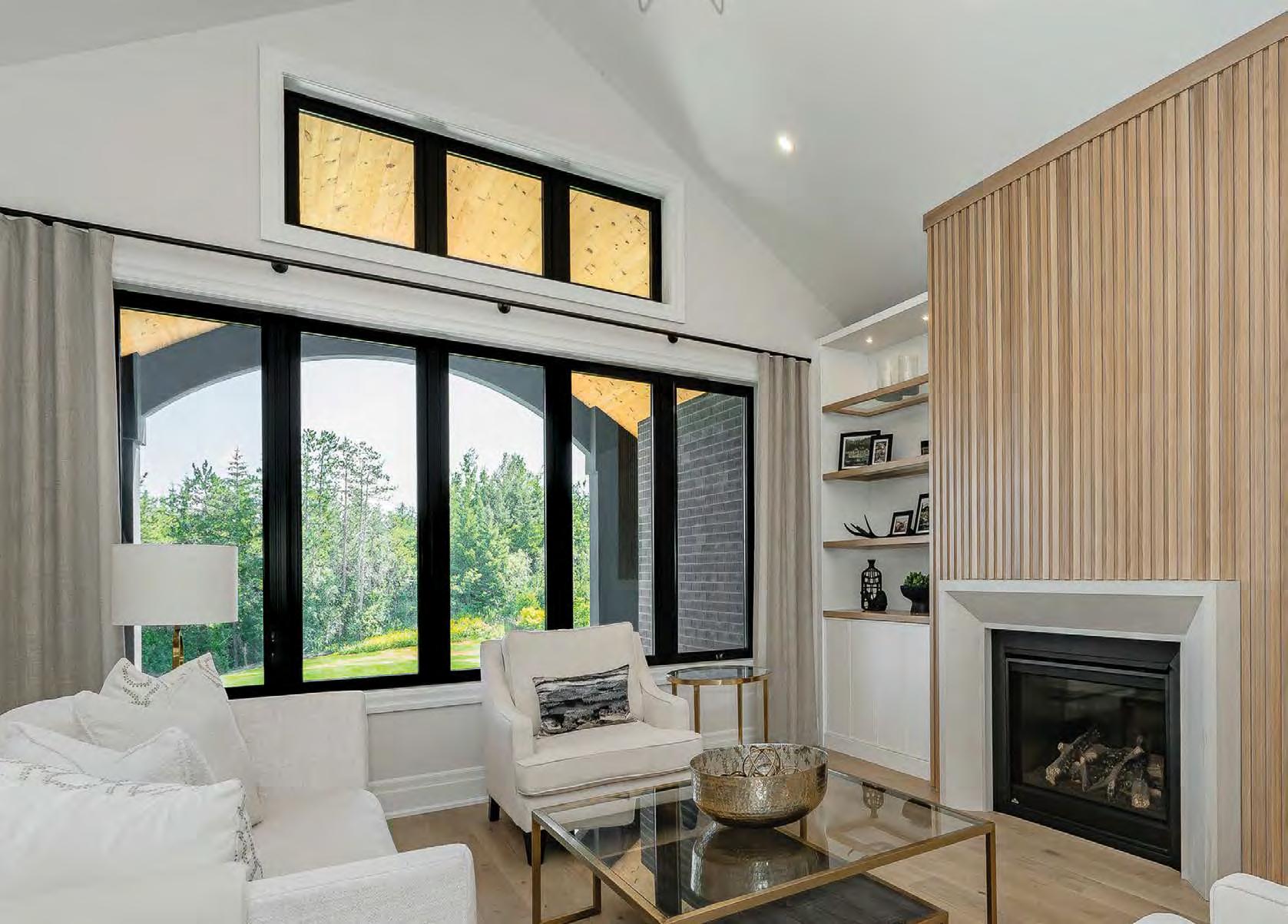






Some of the best builders choose Pollard Windows & Doors for their projects. A proud Canadian manufacturer of quality products, with more than 75 years in business. Pollard has earned the ENERGY STAR Most Efficient mark for Best-in-Class performance. With expert installation, exceptional service and an industry-leading 20-year warranty, you can trust Pollard to be the right choice for new home construction and multi-level buildings.
Aluminum reinforced mullions for larger window configurations For a free estimate today, call 1.800.263.6616 or visit pollardwindows.com


Inverter experience that provides the ultimate in comfort for a homeowner.
• 40% smaller, and 53% lighter than traditional cube style units.
• Environmentally friendly - Now available in R-32, using less refrigerant.
• Ultra quiet and best in class humidity control.
• Available in Air Conditioner, Heat Pump, and Dual Fuel (Hybrid) applications!


It can be the costliest component of new construction, but what are the answers?
By Ted McIntyre


“The next generation of houses in Niagara will be built on land now owned by out-of-region developers.”
Mike Memme, OHBA Chair
THE DREAM of homeownership continues to die for many Ontarians, according to a new survey conducted by Abacus Data on behalf of the Ontario Real Estate Association (OREA). Entitled Housing Affordability in Ontario: Perceptions, Impacts, and Solutions (Wave 5), the survey, released in January, found that “despite a steady desire to own a home (71%), lower interest rates and cooling inflation, homeownership continues to be perceived as expensive, unaffordable and overpriced.” A quarter of aspiring homeowners have given up believing they will ever own a home, while another quarter are pessimistic about the possibility.
Soaring development charges and taxes on new-home sales have been primary concerns, although there is talk of reformation on those fronts. The looming impact of American tariffs could further increase the cost of new homes, but at least they’d be theoretically temporary.
The one constant, however—and it’s a more complex problem—is the price of land. Consider the city of

Vaughan. In 2010, developers were paying, on average, approximately $400,000 to $500,000 per acre for land zoned for residential development. By 2019, the price had risen to over $2 million per acre. And there are situations where that cost is dearer still. “There are recent transactions that go well beyond the $2.5 million-an-acre range for lands with specific zoning that allows for higher density, particularly around major transit areas,” notes FarSight Homes partner Bob Schickedanz. “The higher values of some of these lands are also the result of major changes in provincial planning policy that make it easier to obtain approvals for higher-density projects, which takes some risk out of the project—hence why builders/developers are willing to pay more for that land asset.”
One hundred kilometres southwest in the Kitchener-Waterloo region, a similar story has played out. “As bad as development charges are, land is still a bigger expense per unit where we’re building,” says Rick Martins, V.P. of Kitchener-based Huron Creek
Developments. “Twenty-five years ago, raw developable land in our region was $50,000 to $100,000 per acre. Today, it’s $900,000 to $1 million per acre.”
How do many builders and developers cope with these inordinately high land costs? “They pay more than they are comfortable with, knowing that if they don’t, they won’t have a home-building business in a few years since they’ll have no land to build on,” says Mike Memme, OHBA chair and the operations manager at Mountainview Homes in Thorold. But it’s a high-stakes game, paying interest on that land while “waiting for the market to improve to the point where you can move product without being upside down,” notes Memme, who cites serviced land as composing an average of 25-30% of the price of a new low-rise home in his region. “If you line up financing, invest millions in roads and sewers, go to market and only sell 10% of the product in the first year, you risk losing everything. Right now, our company has land purchased
As bad as development charges are, land is still a bigger expense per unit where we’re building.”
Rick Martins, V.P., Huron Creek Developments

“Many smaller builders don’t get opportunities for lot purchases and either become renovators, go into other businesses or retire.”
Pierre Dufresne, Senior V.P., Cavanagh Communities
and construction drawings done for three mid-rise condos, but we’re not going to market because no one can afford what we’ll have to charge for those units. If we go to market and don’t get the 70% sales required to satisfy the bank, they won’t release funds. And without the bank, you’re not a builder.”
Releasing more developable land into the Southern Ontario greenbelt, where demand is highest, would certainly help alleviate the problem, suggests Martins. “We live in the largest country in North America, yet we restrict the land we can build on as if we have precious little of it. Since the Places to Grow Act (2005), we’ve seen a rapid restriction on new greenfield-, white- and grey-belt land to incentivize intensification. But we’ve still seen a housing shortfall of more than 500,000 homes. When will these restrictive policies be removed? When will practical land-use planning be implemented? In Florida, a builder can pick up a serviced-ready duplex lot for $35,000. That same lot costs $500,000 in Ontario! We have both supply and tax issues that must be changed.”
Memme is a passionate proponent of the provincial government releasing more land for development and says the restriction hurts the housing industry on multiple fronts. “We used to have a large cross-section of builders and developers in Niagara, but with land being artificially restricted, everyone from everywhere is jumping on anything they
can find at any price,” he notes. “The next generation of houses in Niagara will be built on land now owned by out-of-region developers. Restricting the land supply has forced consolidation of the development industry into the hands of those with the deepest pockets. The craftsmen are getting squeezed out by Bay Street.”
It’s a trend Cavanagh
Communities Senior V.P. Pierre Dufresne has seen growing for some time. “Larger land development companies are not only the only ones that can afford large-acreage land purchases, but they also often pay a price the rest of us cannot make any financial sense of, further driving up land costs,” Dufresne says. “They also do not offer retail lots to other homebuilders. That means many smaller builders don’t get opportunities for lot purchases and either become renovators, go into other businesses or retire.”
Colliers Canada Executive V.P. Steve Keyzer, however, believes there is room to grow but that market conditions are currently to blame. “There’s more than enough land within the urban boundary and zoned downtown high-rise sites to fill the housing gap. But right now, it’s a matter of numbers,” says Keyzer, who represents vendors of urban and rural development land throughout the Greater Golden Horseshoe Area but has conducted deals as far north as Kapuskasing, where his firm sold roughly 200,000 acres, and as far south St. Catharines. “Land is pretty inelastic in terms of its reaction to the

“There’s more than enough land within the urban boundary and zoned downtown high-rise sites to fill the housing gap.”
Steve Keyzer, Executive V.P., Colliers Canada
market. It takes years to find equilibrium. And that’s where we are right now. The market is currently mostly void of large transactions. They’re smaller deals—add-on pieces, land assemblies, receiverships. We’ve had some transactions on the brink that were in the $100-$250 million range, only to see purchasers or vendors decide not to go ahead with it based on one or two variables that wouldn’t have been as consequential in the past. The due diligence period has much more scrutiny now, and underwriting and financing are a lot harder because those buckets of debt and equity that were available for land have dried up significantly. So there’s more vendor financing in today’s market, or large builders with those Schedule-A relationships who can still get debt.
“Devoid of government initiatives, there’s currently minimal to no profit for builders, which is why there’s no building,” Keyzer adds. “This could go on for another 12 to 18 months—some think longer, but I’m optimistic. Government initiatives will deliver housing faster than waiting for landowners to discount land. Land has a floor where other uses are more profitable—especially in a dense urban setting. Landowners will discount land only if they need to—if they have a lot of debt or it’s a receivership. They’ll come to where the market demand is. But transactions aren’t prevalent enough yet for a full market reset. Until then, many developers will invest outside of real estate, putting their money in more attractive asset classes.”

Politics and policy are to blame for the predicament as much as anything, suggests Dufresne. “Lands have become overly expensive, but those who make corporate decisions that drive up the price are only doing so due to the policy choices our municipal decision-makers encumber the industry and the home-buying community with. It’s no secret that many municipalities adopt growth management strategies and official plans that actually constrain land supply rather than providing sufficient opportunity
for Ontario’s growing population. Despite the Province’s initiative to build 1.5 million homes in 10 years, compliance by local governments is based upon political decisions by council that are responsive to existing community resistance and advocacy efforts. Ministry of Finance population projections are not being adopted, and unmodelled and unrealistic intensification targets are often used to justify limited settlement boundary expansions. This has led to a depleted land supply for builders to pursue opportunities, as well as land pricing inflating to unaffordable levels.”

“You’re reserving all kinds of infratsructure that could be used to develop other lands better suited to demographic demand.”

Matt Cory, Principal, Malone Given Parsons
You’ll get few arguments from Malone Given Parsons principal Matthew Cory, whose firm specializes in land use and development planning, urban design, growth management strategies and land economics. Cory cited government policy as a key culprit in the housing crisis during his sobering presentation at OHBA’s Central Ontario Housing Summit in late January. The problem isn’t merely that we have emerged from the 2006 Growth Plan for the Greater Golden Horseshoe with a shortfall of all housing types or that forecasts
project a shortage of an additional 100,000 units over the next 20 to 30 years—it’s that we’ve been building the wrong mix of housing all along. In virtually everywhere but Toronto, Cory indicated that the province has a vast oversupply of high-density land but an alarming undersupply of low- and mediumdensity land.
Urbanation’s 2024 Condominium Market Survey bears that out, noting just 4,590 condo sales in the GTHA last year, a decline for the third straight year. This marked a 64% drop from 2023 and a 78%
decline from the 10-year average. While the high-density market is expected to turn around eventually, Cory cautions that it won’t absorb all the market glut if we continue down the same growth plan route.
“To support the 2006 Growth Plan, the Province had Hemson Consulting, who I think does very good work, provide background forecasts for what was needed to house the coming population. The regions then had to implement the Growth Plan, including the policies for intensification. The Hemson forecasting didn’t account for or adjust anything relative to what policy requirements would be in the Growth Plan itself. So the Province did the background forecasting first, then issued a Growth Plan requiring municipalities to hit 50% intensification. And then when they run their numbers, in order to meet the Growth Plan targets you have to change the unit mix from what was originally forecasted. That’s the problem—in order to accommodate the intensification, it forced you to warp the unit mix into too high levels of apartment growth. So now you’re providing many more apartments than forecasted, and there’s a real question about whether they’ll even be needed. The problem is further compounded by committing infrastructure dollars to that. It’s not realistic, and it’s a very financially risky and costly way of doing development because you’re reserving all kinds of infrastructure and allocations that could otherwise be

“In searching for development land, the primary consideration, particularly with today’s restrictions, is planning status.”
Bob Schickedanz, Partner, FarSight Homes
used to develop other lands better suited to demographic demand—all because you’re holding out for this forecasted intensification. So we ended up with a systematized unrealistic housing mix forced by the Growth Plan.”
Halton exemplifies the resulting housing mismatch in municipalities across the province. Of the region’s 17,800-unit shortfall after the Growth Plan, 12,600 were low-density, 4,600 were medium-density, and just 600 were high-density. The projections moving forward (2021-2051), assuming the current path, indicate a continued divergence in that path, with an estimated shortfall of 45,900 low-density units but a surplus of 47,400 high-density units.
The numbers are repeated across the GTHA, where the overall projected shortfall of grade-related housing is 206,800 units by 2051, with a surplus of 326,800 high-density units. “But in fairness to Halton and the other regions, they were required to hit the targets of the Growth Plan,” Cory explains. “They had to plan for 50% of all the new residential units to be through intensification. Most of that would need to take the form of apartments and condos. Around 50% or more of all the GTHA housing for the next 30 years is planned to be apartments and condos, whereas the forecasted need is closer to 30%. So we have an opportunity, now that the Growth Plan is gone and a new provincial planning statement is in effect, to revisit those assumptions. Otherwise, we will knowingly make it worse and risk people not coming
here at all, with people and businesses moving out of the GTHA.”
If things are to improve, a little planning assistance would be appreciated. “In searching for development land, the primary consideration, particularly with today’s enormous restrictions and red tape, is planning status,” says Schickedanz. “Are the lands in the settlement boundary? Are they zoned? Do they require a secondary plan? Do they have upper-tier and or lower-tier planning status? These and other metrics are important.
“But just as important, and often overlooked, is whether infrastructure is available,” Schickedanz continues. “You can’t build the house if you can’t flush the toilet. While this is getting broader attention lately, critical investment in expanding and maintaining municipal infrastructure, particularly sewer and water, has been dwindling for decades—to the point where in the vast majority of Ontario communities, there is minimal capacity of systems to support the 1.5 million homes we need to build. This is a difficult problem to overcome, one that requires vast sums of money, which is reflected in the enormous development charge rates and years of lead time for the required environmental assessments, engineering designs and construction timelines. Just look at the Eglinton Crosstown LRT in Toronto! So when I conduct due diligence in purchasing candidate development lands, regardless of the planning status, if there isn’t a reasonable solution (time and
money) to resolve how the land will be serviced, I’m not interested unless there is a very steep discount in the purchase price—which is not happening, hence the problem.”
“There are three things that can happen quickly to help release land for development,” Cory says. “The first—and easiest, since it doesn’t cost a thing—is to release infrastructure capacity currently reserved for unrealistic intensification so that these lands can be developed with more low- and mid-rise housing. One of the challenges is that about half of the greenfield areas that were introduced in the past are still vacant and waiting to be developed. A lot of them are held up by the lack of infrastructure.
“The second thing is triage—to prioritize infrastructure investments on lands already slated for development,” Cory continues. “And third, additional lands are required to accommodate as many forecasted grade-related housing units as needed for the 2051 horizon. If we are to stem the anticipated housing crisis, those lands must be brought on now, with long-term planning and infrastructure requirements assessed. So we’re talking about near, mid-term and long-term housing supply solutions.”
As to the latter initiative, if the gates to developable land are to swing open, it might be in the hands of the next generation, suggests Memme. “Our children have been decimated so completely that they’ll open the land up without question,” he predicts. “It’s just going to take another 15 to 20 years before they’ll be the ones calling the shots.” OHB



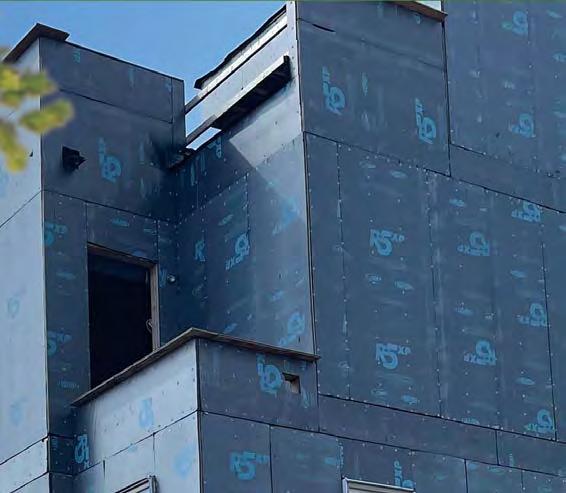




High performance
Bio-based building materials
Recycled wood fibre sourced from post industrial and post consumer origin

BP’s R-1.5 exterior sheathing panel provides structural strength, noise reduction, superior water vapour permeance at 37 perms, and a remarkably low carbon footprint, at a value based pricing. R-1.5 Continuous superior water vapour permeance – a perfect combination for our canadian climate.


BP’s Excel exterior sheathing panel provides R-1.5 of continuous insulation while providing superior structural strength, weather resistive and air barrier properties ensuring that your walls remain warm and dry, mitigating moisture entrapment in the wall cavity.



BP’s R-5 XP exterior sheathing panel provides R-5 of continuous insulation using Dupont’s low GHG STYROFOAM™ Extruded Polystyrene, laminated to a ½" high performance wood fiber panel. The overall panel assembly provides a water vapour permeance rating of 2 perms, ensuring an optimal performance of your overall building envelope.

How to frame your marketing for the




eave you heard this one? A baby boomer, a millennial and a Gen Zer walk into a
Of course you haven’t. When it comes to new-home marketing, it’s not one-campaign-fits-all—and the sales office isn’t the magnet it used to be. Real estate marketing has embraced the digital age. Campaigns are tailored to different demographics through their preferred content consumption
method, interests and needs.
Debbie Cosic, CEO and founder of In2ition Realty Brokerage, says today’s marketing must be very targeted, and marketers need to drill deep. “You have to fine-tune your story and your market,” Cosic notes. “The story has to be different for each group, and you must target each market differently. People aren’t walking into sales offices anymore.”
It’s important to know potential buyers and do an analysis before any campaign rolls out, explains Linda O’Connor, principal of Ryan Design International and winner of the BILD 2024 Riley Brethour Leadership Award. “We look at the target audience and want to know their dreams, desires, what they are afraid of, what’s motivating them, what their strengths and weaknesses are, their biases and where to find them.” That analysis highlights the preferences of each generation and enables O’Connor’s team to develop effective marketing plans.
Riel Sammy, principal and strategic director of Channel 13 Advertising & Design Inc., starts brand planning early in the process, determining what a builder is trying to achieve and what special features are offered by the project and its surrounding area, among multiple other details. “I try to understand the project perspective, then move on to the location, understanding who is living there now, what its strengths and weaknesses are, and what opportunities may come from the strengths,” Sammy says.
Low-rise marketing also depends on the product design, says Cosic. “We aren’t going to market three-storey stacked townhouses to baby boomers, but to millennials and Gen Xers. Boomers want fewer stairs, one or two levels and traditional architecture.”
With condos, various demographics live in the same project, “So what we’re doing is stratifying the marketing and design,” Cosic indicates. “We’re designing smaller suites for younger buyers and investors, and middle-sized for suites Gen Xers who don’t want to live in 500 square feet and want at least 1,000 square feet. Each group will require a different marketing approach.”
Jessica Frutti, V.P. of sales and marketing at Eleven Eleven Realty, says marketing is heavily dependent on location. Her agency handles projects
in the Greater Golden Horseshoe, including Niagara, Cambridge, Guelph, Stratford and Durham Region, plus Muskoka and Collingwood.
“Collingwood is a natural retirement area, but there are a lot of families there,” she says. “It’s a weird dichotomy because you don’t have that middle group. You have people in their mid-20s and 30s, then true retirees.”
Stratford has a similar dual nature. It may become a large retirement area

but is also attracting people with families who may work in the KitchenerWaterloo tech industry. For locations like those, it’s important to identify common interests regardless of age, such as recreational activities.
Channel 13 is marketing the newest phases of Mason Homes’ Lakeside Village in Port Hope, and he says it’s a much slower sales process than in the 416 or areas of the 905 closer to Toronto. “It’s not just about the
“We look at the target audience and want to know their dreams, desires.”
is the most digitally engaged of the groups, spending an average of 6.6 hours daily consuming digital content. Platforms like Facebook, Instagram, TikTok, Snapchat and YouTube dominate their attention, with 60% turn ing to Instagram and TikTok for entertainment and news. They prefer short-form, visually engaging content, and value authenticity and relatability in messaging. They are strongly drawn to eco-friendly homes, with 81% advocating for sustainable prac tices and 78% prioritizing smarthome features like app-controlled systems and energy monitoring tools. Their mobile-first behaviour—98% own smartphones—makes mobile-optimized campaigns critical for reaching them.

(10 0+ years)
(80 to 99 years)
(60 to 79 years)
(29 to 44 years)
(13 to 28 years)
SOURCE: STATISTICS CANADA | ZONDA URBAN (Percentages
Millennials (1981-1996) average 5.7 hours of digital media consumption daily, splitting their attention between platforms like Facebook (87%) and Instagram (71%), along with streaming services such as Netflix and YouTube. They prefer blogs, videos and detailed written content when making decisions. Sustainability is a priority, with 83% seeking energyefficient homes and many willing to pay 10% more for green-certified properties. Smart-home features like voicecontrolled systems and smart thermostats appeal to 77% of millen nials, driven by convenience and long-term cost sav ings. They actively use mobile apps for research and communica tion during the home-buying process.

transaction; it’s about people becoming part of the community,” Sammy says. “People who don’t live in the area may not know where Port Hope is, what it’s about, why it’s charming. It takes more time for that education.”
He says the project will appeal to empty nesters and potentially Gen Xers and baby boomers. Empty nesters in the 60-65 age range are nearing retirement, have some flexibility in their work life and can be further away from the city, have more time to enjoy leisure activities, and want more home for less money.
The explosion of social media has dramatically changed the way housing is marketed. But some traditional forms of advertising, such as print, signage, TV and radio, are still used.
“Everyone is on Facebook and Instagram, all age groups,” says Cosic. “We target age groups, demographics, areas. The 25-to-40-year-olds enjoy Instagram, blogs, lifestyle content and TikTok. Gen X takes more time and wants
a ‘Show-me-why-should-I-buy-this’ approach, so we use emails, webinars and information sessions in sales centres. Baby boomers want a very personalized approach, so we reach out via phone calls or personalized direct mail communication, emphasizing conveniences, safety and the security of the investment. If it’s a condo with a mixed demographic, we will market to all groups simultaneously but mix up the content to appeal to the different age groups. Most people like to live in mixed-demographic buildings. We’re very strategic in our campaigns, but we cover them all.”
Sammy likes digital advertising that can be tracked, such as Google searches, Facebook and Instagram, and has a “plethora” of ad types for each platform. “When we have a sense of potential buyers’ age range, we can target their interests and geo locations.”
Sammy’s team will also use specific publications that target the demographic they are aiming at, as well as purchasing radio ads. “It creates more brand awareness and is another touchpoint to get people searching online,” he explains. “Once someone registers, you can nurture them through email. People don’t click on an ad and then come in and buy. It becomes part of their thinking. They sign up for email. They may register but not be totally ready to buy; they may shop around online and get a few emails before they come to visit you.
“We start with digital to validate a lot of the things we’re doing, and that allows us to fine-tune our marketing,”
Sammy says. “We use social media and Google search to understand who these people might be and what they’re looking for. When we start, our vision is far into the distance. Then as we walk forward, our vision gets clearer.”
Sammy is working on a campaign for a Meaford development offering resortstyle living. Buyers could be looking for a second residence, a ski chalet, an investment property or a four-season home. A digital strategy will be the baseline for the marketing, supplemented with signage people will see as they drive north from the GTA and in nearby Collingwood. Advertising will be purchased in publications specific to the lifestyle and location.
“This will be more grassroots, and we’ll go to private ski hills and golf
clubs, offer incentives to members, and aggressively use Google search, Google display ads and all the Facebook ad platforms,” explains Sammy. Influencers and launches can also be part of the marketing mix. “I haven’t done influencers, but I have colleagues in the city who have done it with success,” says Frutti. “There’s Cameo too, an app where celebrities send personal messages and do shout-outs for a project. It’s cool and unique and puts eyes

Riel
principal and strategic director of Channel 13
Advertising & Design Inc.
on a project. But I don’t yet know what the conversion to sales has been.”
Launches are back, says Frutti, and they can create organic social media. “There are agents we’ll invite who work to get a lot of followers and who do a good job of building and maintaining client bases through social media. Some may go the educational route, and some make flashy videos, almost like a movie.”
“When we have a sense of potential buyers’ age range, we can target their interests and geolocations.”
(1966-1980) balances tradi tional and digital media con sumption, spending about 3.9 hours daily on digital platforms while still engaging with tradi tional media like television and print. Facebook (76%) remains their primary social media platform, supplemented by LinkedIn for professional networking. This generation values energy-effi cient homes, with 62% prefer ring features that reduce costs, and 50% showing interest in upgrading homes with smart tech nologies such as lighting and security systems.
While desktops and tab lets are more commonly used than smartphones, they appreciate a bal ance between informa tive content and visual advertising.

Frutti says if her agency holds an event and gets 30 or 40 blasts on social media, “that attention lasts for a moment in time.” Her agency builds its own database and does e-blasts and emails with registration options. Once buyers are registered, it’s time to invite them to the sales office. “Boomers want to sit and talk; they don’t want to be in a room of 100 people. It’s about relationship-building, one-on-one or two-on-one appointments. If it’s a product for the younger generation, on the other hand, I’m packing that room, as I want them to feel the urgency.”
What do these different groups want and how does that inform the marketing for a project? Generation Z wants more convenience, and if they have a good job in a city centre, they want amenities at their doorstep and to socialize with friends rather than spending a lot of time on maintenance, says Sammy. Affordability in their desired location carries much weight for them.
“Gen Z buys mostly through real estate agents,” says Frutti. “They want flash and immediacy. The home doesn’t have to be big, and you can sell them upgrades, but they have to be able to visualize.”
Gen Z also wants a great value proposition, whether it’s a condo or purpose-built rental with high-quality features and finishes, Frutti says. To reach them, “we will advertise in cool publications or sites such as Toronto Life or Blog Toronto,” in addition to social media.
Gen Xers tend to be cautious about home-buying decisions. One reason is they experienced multiple recessions as children and young adults, says O’Connor. They are “all about family,” and many want a house with an in-law suite, a loft upstairs or a basement apartment, or are buying a future home for their kids, says Cosic. “People are being smart and buying upfront now. They know their kids will not be able to get into housing otherwise.
dedicate 4.2 hours daily to traditional media like television and newspapers, although their digital presence is growing. Facebook is their primary digital platform, with 70% using it to stay connected and access information. Email campaigns are partic ularly effective for engaging this group. They are gradually adopting smart-home features, with 35% showing interest in basic technologies like voice assistants and security systems, while 47% prioritize energy-efficient homes to reduce utility costs. Laptops and desktops remain their preferred devices, making user-friendly websites and straight forward messaging key to reaching this audience.
—Source: Linda O’Connor, RyanDesign International
They will rent it out until their kids are ready to take it over.” Cosic calls them “tiptoe investors”—quietly buying for their family in the long run, even though it could be five to 10 years until the time is right.
“Gen Xers are the hardest, unless they are investors—then they are the easiest,” says Frutti. “They want what their parents had and are old enough to remember when things were really good price-wise. They are less trusting of our industry as a whole and consume content through social media.”
That said, Eleven Eleven will do signage and billboards in places such as Stratford or Niagara, where Gen Xers may be visiting, see the signage and come into a sales office on a whim.
However, says Frutti, “they don’t want to be somewhere on the cusp of transition or somewhere that will be under construction for years to come. They want community-oriented amenities such as schools and parks.” Frutti has had success marketing homes in Fort Erie to Gen Xers, as “the communities are gorgeous—there are established schools, mature trees and a finite number of homes built there. That’s part of the appeal.”

Millennials now represent the largest home-buying cohort, Cosic notes. “They are very digital and want online content. They like visual things; they want location and design. They respond to influencers and Instagram. They want trendy and hip.”
That’s why an effective campaign on social media will play up spectacular amenities that will appeal to them, such as hot and cold plunge pools, meditation rooms or social media studios, says Cosic. “Many of them have side hustles and are selling on Amazon or working as influencers.”
“Millennials typically prioritize affordability, convenience to work, commute times, energy efficiency, open floor plans and modern features,” says O’Connor. They also prefer low-maintenance and easyto-care-for outdoor spaces. They often turn to products that offer in-law suites or two residences in one, such as Spaces from Heathwood or DUO from eQ Homes, both
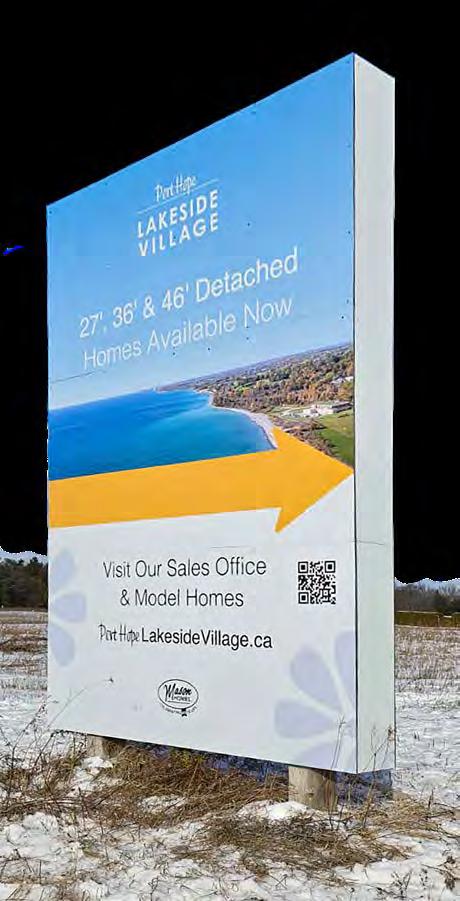
of which O’Connor is marketing. “We find that families helping families are key purchasers of these two products. Going to the Bank of Mom and Dad is easier if Mom and Dad also live under the same roof and help to pay the mortgage.”
Frutti says millennials are split into two groups: the younger ones and the ‘elder millennials’ in their late 30s and early 40s, who are more established and prepared to spend more money. They have a negative view of the real estate industry and are more comfortable purchasing through an agent.
As for older baby boomers, most want to live closer to family members in retirement, says O’Connor, while others want to downsize. As the generation most likely to purchase a home in a small town, baby boomers want to live in a safe and peaceful city. While older baby boomers tend to purchase the newest homes on average, with single-storey layouts and low-maintenance features, younger baby boomers tend to move the furthest distance and live in their homes for the most extended period.
Then there’s the silent generation— those born from 1928 to 1945—and the second-most-likely group to buy new construction homes. They want convenience and access to top-rated

“We aren’t going to market three-storey stacked townhouses to baby boomers but to millennials and Gen Xers.”
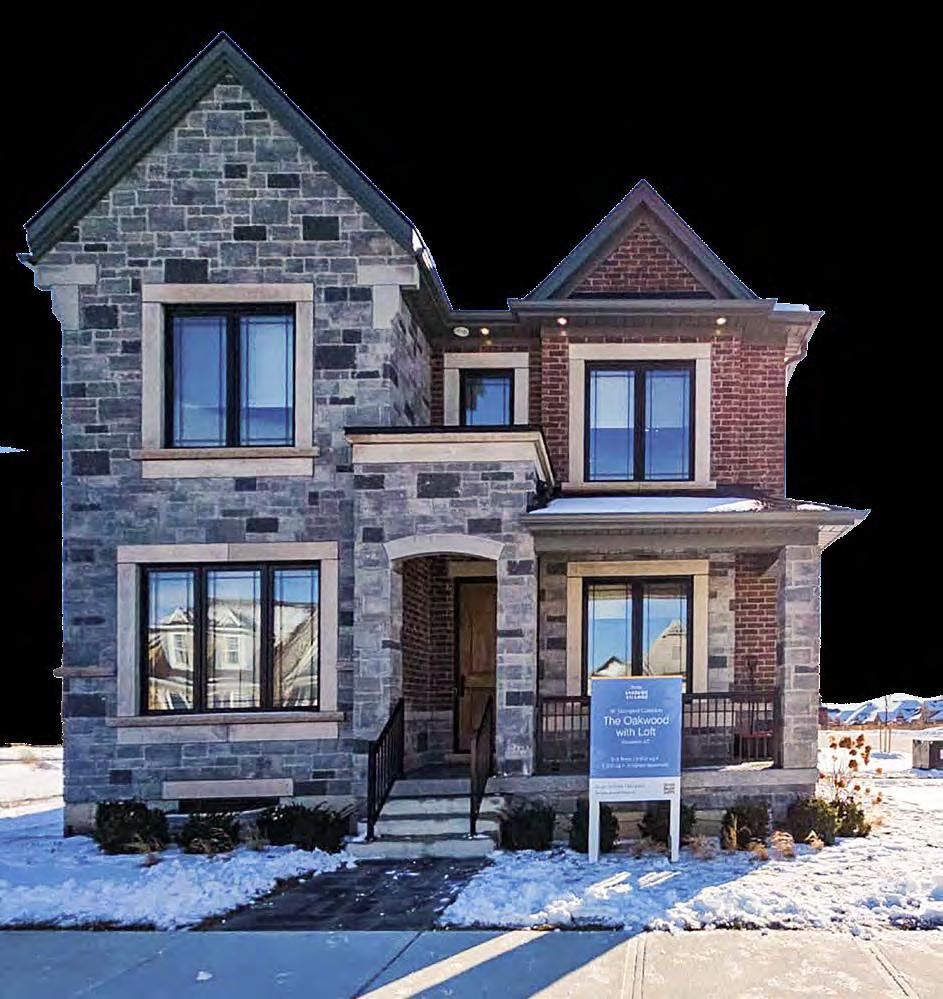
healthcare facilities, says O’Connor. They want to downsize to smaller homes to save money, enjoy accessible features, and gravitate toward purchasing homes in established neighbourhoods with a strong sense of community.
“The issue with marketing communities to people 55-plus is that those communities end up with a large cohort of the silent group because they are living longer,” says O’Connor. “That makes the overall community harder to market to younger boomers. People want to live where they can thrive and garner energy from their surroundings.”
O’Connor says it’s important not only to watch population growth but changes within the categories year to year. The Silent Generation, for example, makes up just 4.5% of the total population but grew 3.5% yearover-year in 2024.
Regardless of the demographic, digital technology has been a gamechanger in the new-home industry. With its ability to collect data, target specific buyers, build brands and tell hard-to-resist lifestyle stories through compelling visuals and social media hashtags, it will continue to be a critical component in the marketing of new homes. OHB






Learn how Continuous Insulation can keep you a step ahead. DuPont™ Styrofoam™ Brand XPS is an easier, future-proof way to build Low-GWP Styrofoam™ Brand XPS Insulation is now grey and offers a 94% reduction in embodied carbon.

© 2024 DuPont. All rights reserved. DuPont™, the DuPont Oval Logo, and all trademarks and service marks denoted with ™, ℠ or ® are owned by affiliates of DuPont de Nemours, Inc. unless otherwise noted.



To become a member of the Ontario Home Builders’ Association (OHBA) you first join a local home builders’ association, one of the 28 across Ontario. Once a member of your local home builders’ association, you will automatically become a member of OHBA and the Canadian Home Builders’ Association (CHBA).
Scan the QR code below to find your local home builders’ association!

1
Local Membership Build Local Relationships Influence Local Policy Become a Community Leader
2 National Membership
3
Provincial Membership Have a Voice in Provincial Policy Network with Industry Leaders Access Training Opportunities
Foster a National Network
Access Exclusive Insights Become a National Leader

News and moves from the industry
stories of midsized locations that have grown into larger cities, such as Raleigh-Durham in the U.S., Bologna in Italy, Germany’s Ruhr Valley and Galway, Ireland. Quoting authors Giulio Buciuni and Giancarlo Coro in their 2023 book Competitive Suburbs, the paper notes that “global connectivity, the interplay of local universities and the private sector, and local finance and entrepreneurship are the three factors that make secondary cities competitive. For this model to succeed, all three factors must be in place simultaneously.”
How do we curtail soaring land costs in our biggest cities? Give the population alternatives in which to settle and work by growing more big cities! That’s the proposal of a new report from the C.D. Howe Institute that urges policymakers to target a small set of mid-size cities and support them in becoming thriving, larger hubs, which would meaningfully reduce housing costs nationwide.
In Making Housing More Affordable in Canada: The Need for More Large Cities, Dr. Jeremy Kronick and Professor Paul Beaudry argue that focusing exclusively on boosting housing supply in big cities is insufficient to improving affordability, as it is offset by increased in-migration from smaller cities, which simply leads to more Canadians living in our expensive few big cities.
“We’ve been building more housing than is often acknowledged, but our efforts need to extend beyond Toronto and Vancouver,” says Beaudry, former Deputy Governor of the Bank of Canada. “We should identify a small set of cities with the strongest potential to grow and succeed and support
them to become new large cities.”
The report finds that strengthening mid-sized centres like Kitchener/ Waterloo, London and Kamloops—by improving infrastructure, encouraging local business growth, forging university partnerships and making it easier to build—can reduce in-migration into our big cities, mitigating price pressures there, and help lower costs for everyone.
“Secondary cities must reach a scale where they can harness agglomeration benefits—clustering industries and people to drive job creation, innovation and productivity,” Kronick says. “Big cities will always draw talent and investment—and they should. But by growing our secondary cities into attractive destinations, we can reduce housing pressure on major urban centres and make affordability a reality nationwide.”
Investing in transit links that connect large and smaller urban areas is among the recommendations, and “some subsidization of infrastructure will be necessary to direct the marginal dollar towards these locations,” the report notes.
The paper highlights global success
The common thread of funding worldclass research at universities makes cities like Kingston (Queen’s University) and London (Western University) prime candidates in Ontario.
Kronick admits there could be an element of organic growth needed—the international cities mentioned above were not the result of government mandates to make them bigger—but the building blocks remain similar, Kronick says.
“There’s so much evidence in the power of big cities, and we’re not saying that shouldn’t continue,” Kronick indicates. “We’re just saying that if we want affordability, we need to do more. Think of transportation policies in a place like Kitchener-Waterloo, where they improved GO service. That made it easier for people to work in Toronto but live in KW, and there was a noticeable impact on population growth.”
Light House, an organization focused on advancing regenerative and circular practices in the built environment, has launched a new initiative to divert and upcycle plastic waste from approximately 10 Metro Vancouver construction sites. The pilot program, The Construction Plastics Initiative, is running until February 2026.
Its objective is to demonstrate the feasibility and financial viability of a


circular economic model for plastic waste generated on construction sites. The intention is to collect, separate, measure and process plastics from construction sites to determine the amount and types of plastic waste being generated in B.C.’s construction sector and to divert and repurpose the plastic into new products. Project participants can showcase their leadership by pioneering plastic diversion and using locally manufactured building products in their projects.









“Currently, there is a lack of studies in North America quantifying the volume of construction plastic waste directed to landfills,” says Gil Yaron, Light House’s managing director for circular innovation. “Studies from Europe suggest approximately 80% of plastic waste from on-site construction consists of clean packaging materials readily divertible from range of new building products. Although not introduced to Ontario as yet, builders seeking information can visit Light-house.org/cpi.

The forecast is mostly gloomy from CMHC’s 2025 Housing Market Outlook
“We expect sales in Ontario and B.C. to remain below their 10-year averages. This is due to ongoing affordability chal lenges and the notable impact of new (lowered) immigration targets.” Prices here will “grow more slowly, especially in the first half of the forecast period.”

In Ontario, “Pre-construction condo apartments, often bought by investors, will see lower demand due to weaker resale and rental markets. This will lead to new construction slowing down.”
However, the outlook is so unpredictable that CMHC’s forecast has two different scenarios. A low-growth scenario sees high tariffs from the U.S. resulting in job losses and a recession. Inflation temporarily rises, but the central bank lowers the policy rate to support the economy. Financial uncertainty inches up borrowing costs, while tighter U.S. borders lead to higher-than-anticipated immigration in Canada.
This would delay the housing recovery, increasing pent-up demand. By late 2026, the economy will rebound, with a growing population boosting home sales, but rental markets will stay tight.
The alternative high-growth scenario sees the U.S. introducing fewer and shorter-lasting tariffs, while U.S. government spending boosts Canadian exports. Canadian immigration meets recent targets, higher incomes and stronger consumer confidence encourage more spending, and stronger declines in borrowing costs make homeownership more attainable.
This would see more homes built thanks to better financing and business conditions. Stronger job and income growth combined with lower mortgage rates would make homeownership more accessible. But higher demand would push home prices up more quickly.
Architecture design is about to get much easier—and faster—with the





launch of the AI Assistant from software provider Nemetschek Group. It’s the company’s first AI-agent-based technology for architecture-engineering-construction industry design software Archicad.
Streamlining creative exploration while saving time and ensuring quality and compliance, the AI Assistant will be embedded directly into Archicad as an integrated AI chatbot. It will feature product knowledge, industry insights, BIM model queries and AI Visualizer integration. Users can design and refine projects through a timesaving chat interface. Want to view just the HVAC network of your proposed project, or what the structure looks like in wood or brick? Do you want to identify doors with unspecified fire ratings? Just type your specific inquiry into the chatbox and the software will instantly highlight the answer within the design.

Slated for an official launch this fall, AI Assistant will also be available in BIMx, Graphisoft’s award-winning presentation and coordination app. Using a mobile phone, iPad or even Apple Vision Pro, users can quickly and easily navigate a project away from the office or on the construction site.
MNP and BDO, two of Canada’s leading professional services firms, announced on Dec. 23 that MNP has acquired 21 BDO Canada offices, including more than 40 partners and 420 team members. The transaction includes selected locations in B.C., Alberta, Ontario and P.E.I.—provinces where both firms have offices.
“MNP is a homegrown Canadian firm that was established in 1958. With the
addition of the new offices, we will have nearly 150 offices coast-to-coast, including in the largest urban centres, mid-sized cities and the smaller rural cities and towns we find across all provinces,” says MNP Chairman of the Board and CEO Jason Tuffs. “Our specialized services, expertise and experience will be enhanced by the BDO partners and team members who are joining us.”
Ontario BDO locations included in this transaction include Collingwood, Dryden, Fort Frances, Hanover, Kenora, Kincardine, Lindsay, Mitchell, Mount Forest, Orangeville, Owen Sound, Peterborough, Port Elgin, Thunder Bay, Walkerton and Wiarton.
The Daniels Corporation is making its Accessibility Designed Program (ADP) Technical Standards Guide public for the first time—giving the industry a ready-made blueprint for integrating accessibility into new housing developments.
The timing is good. According to the most recent Canadian Survey on Disability, 27% of Canadians aged 15 and older—roughly 8 million people—now live with a disability, up from 22% in 2017. And it’s an issue that will intensify. According to Statistics Canada, the proportion of Canadians aged 65 and older is set to soar from 18.9% in 2023 to 32.3% by 2073.
Despite federal commitments under the National Housing Strategy to expand accessible housing, progress remains slow due to cost barriers, inconsistent regulations and limited industry awareness. However, Daniels is addressing the issue by releasing its ADP Technical Standards Guide, providing a clear, actionable framework to advance accessibility in housing.
Introduced in 2017, the guide exceeds Ontario Building Code requirements with features that enhance livability for people using mobility aids, those with sensory, cognitive or intellectual disabilities and individuals aging in place. By sharing these standards, Daniels is urging developers, builders, architects and designers to adopt these practices to drive industry-wide change. OHB


















By Ted McIntyre
A SURGE IN HOME invasions and stolen cars has Ontario residents on alert. A sobering example was a Nov. 30 report from Global News that noted 17 cases of home break-ins in Oakville since Oct. 1—“an alarming increase compared to 24 home breakins reported in all of 2023.” Many occurred with residents still at home.
News like that has more homebuyers understandably thinking about security. That means builders are doing the same. From AI-driven surveillance systems to biometric entry methods, Ontario’s homes and condominiums are becoming fortresses powered by technology.

at DBS Developments' 2Fi fteen luxury apartments include a 24/7 doorman and concierge, as well as a touchless elevator system.
It’s even the case for rental buildings, as evidenced at 2Fifteen in Forest Hill, the most recent purposebuilt luxury apartment from DBS Developments. 2Fifteen marries new technology with old-fashioned security to safeguard its property and residents.
“Similar to a five-star hotel, it has both a doorman and concierge 24 hours a day,” notes DBS CEO Bryan Levy. “We have the Destination Dispatch touchless elevator system, which has no physical buttons in it and only allows residents to access their particular floor or floors with amenities through a digital fob.”
Beyond the security benefits,
Destination Dispatch also provides more efficiency for multi-elevator installations, grouping passengers for the same destinations into the same elevators, thereby reducing waiting and travel times compared to a traditional system. And then we have electronic Salto locks on all suite doors. To enter the unit, you must have access to 2Fiteen’s custom Rise app. For cases where you have, for example, a dog walker coming in, you can give them a digital pass to access the unit. The technology also allows for a digital trail of everyone who has entered and exited your suite.”
Visitors of residents, once verified by the concierge, are walked to the elevator and provided access to only the required floor.
The concierge and doorman have full and constant camera access to the building and outdoor area, including motion detection cameras. “They essentially have eyes on all access points,” Levy says. “All these measures
combine to create a bubble of enhanced security around the property. And on the rare occasions when a situation required escalation, the police response has been very rapid.”
DBS is installing the Salto locks on all its new purpose-built rental sites, Levy notes, and the advantages begin long before residents move in. “During construction, you can allow trades or contractors access to suites. And whereas in the past we would’ve needed a key runner to lock up all the suites at the end of the day, we can now do that remotely.”
Levy says the feedback from 2Fifteen residents has been strong. “We see a lot of people looking to live in a building like this because they’re uncomfortable even being in a house, in a situation where they don’t have that many layers of security. We’ve also had residents who have referred friends to come to live here. They know there are no unwelcome guests who can access the property. And
could get to your floor, they can’t get into your suite.”
Graeme Armster, director of innovation and sustainability at Tridel, appreciates the fear factor of many Ontarians. “Tridel conducts extensive feedback surveys, asking customers to rank the importance of a long list of services and solutions ranging from finishes to smart-home features,” Armster shares. “Security has ranked No. 1 on all our most recent surveys.”
Upgrades of access control systems at condominium-like buildings are coming fast. “Previously, the only digital system for security management and access has been in common areas—one that required card readers and fobs,” Armster notes. “Smart digital door locks are more recent. The first time we did that was in 2018 at our Ten York project, which blew the roof off the smart building industry. Since then, almost everyone has followed suit. But there are different levels of intelligence with a suite door lock. Most out-of-the-box smart locks from retailers, which connect to your home wifi, allow you

to remotely pull up an app to see if the door is locked or send temporary key codes to give others access. But most building vendors have only been implementing a data-on-card solution, which allows you to manage credentials from a central facility in the building. So I can assign one fob to a homeowner that allows them into the building, through the elevator and into their unit. This is a great solution for rental building developers, who care a lot about the building as a whole and who’s coming and going. But as a condo owner, you may want access to all the remote features of modern smart locks. I think this is a transition the industry is about to go through.
Tridel has gone through subtle iterations of this technology since Ten York. “We’ve been working with vendors like CityLink, SmartOne and 1Valet, who integrate the building management software with the building’s access control system and smart-lock solution, as well as the suite’s thermostat and intrusion alarm,” Armster explains. “It’s all on a single platform
Integrated systems from 1Valet and other technology allow residents at Tridel's The Well to do everything from facial-scan entry into the building to being able to book and privately access common rooms.

and app that new residents can download and set up. So they don’t need a fob—they can utilize their phone to do all sorts of stuff. I can book the party room from 7-11 p.m., and it’ll be locked off for everyone else, but allow me to enter. When I get home from work, I can scan my phone to enter the building, to go up the elevator and to enter my unit. And if there’s a power outage or a loss of cellular connectivity, those credentials are stored on your phone, which goes into something akin to airplane mode and works through Bluetooth to communicate with devices locally. If I’m home or not and someone were ever to force their way into my suite, the alarm would go off and immediately notify my phone and the concierge. This system is available at The Well.”
Residents at The Well can also enable biometrics (facial) to enter the building from street level. “That’s where I think things will go in the future—a system where you don’t need anything to gain access—just you, with your phone only required for backup,” Armster says. “A biometric scan will get you in the building, up the elevator and into your room.”
High-tech access controls and 24/7 concierges are one side of the security equation; the other is cameras and
Weiser's Halo Select uses either wifi or Matter and Thread technology. Geofencing allows the option for autounlocking as you approach the door.
“We
CCTV recording. And it’s a delicate balancing act, Armster says. “You want cameras deployed in a way that makes residents feel secure, but not so much that it invades their privacy.”
And where is all the security footage stored? “You only have so much server space. We generally keep around 30 days of footage on site. But do we migrate everything to the cloud in the future? It’s something we’re looking at.”
Additional layers of technology often provide additional opportunities for hackers, but Tridel takes cybersecurity particularly seriously. “We hire an ethical hacker as part of our penetration testing—where a consultant comes in and does a full physical and virtual security audit, right down to trying to pick locks,” Armster shares. “We get a full deficiency list of physical and virtual things that need to change. It might even be something one of our service providers, like 1Valet, needs to address so that the building is secure when we turn it over.”
To that end, Tridel also includes a

requirement within their condo docs for the condominium corporation and board to conduct a security audit a minimum of every two years. “Any time you have internet coming into a building, that’s a virtual doorway, so you had better make sure it’s secure,” Armster notes. “So if a vendor the condo corp is working with does a major software update, we recommend the condo software gets audited too.”
On the low-rise side, one of the most common security features in recent years is the smart doorbell, which allows homeowners to monitor and communicate with visitors via their smartphones, no matter where they are. These devices are often equipped with high-definition cameras, motion sensors and two-way audio, offering homeowners an added layer of convenience and security.
Here are some of the latest products that can be integrated into any new home build. (Note that the following may require ongoing memberships to harness all features.)
Weiser’s newest touchscreen lock combines keyless convenience with secure performance and flexible smart-home connectivity. Users can employ either wifi or Matter connectivity (the latter via Thread) to use their device, both of which are built into the product. Thread is a networking protocol that makes it easy to connect all your smart devices, offering lower power consumption, local control and mesh networking. With Thread, your devices create their own network, ensuring all smart devices keep working smoothly, even when the wifi goes out.
The Halo Select allows homeowners to remotely lock and unlock, share up to 250 temporary, scheduled or permanent access codes, and ensure

Apple is reportedly entering the smart doorbell market, with a facial ID option to unlock your door.
Backed by a best-inclass BMHA rating, Schlage's Arrive Smart WiFi Deadbolt features Schlage's first push-button keypad deadbolt lockwith built-in wifi.

their door is secure, while receiving real-time phone alerts if invalid code attempts or lock tampering occur. They can also view the event log with door and lock status for peace of mind. Since it works with Amazon Alexa, Apple Home and Google Home, users can manage all their smart devices on one app. Geofencing allows the added option for automatic unlocking as you approach your home—or you can unlock using the Weiser app or simply enter a code on the touchscreen (its bright LED-backlit touchscreen provides easy code entry). It also includes two physical keys as an additional way of entry.
With no hardwiring required, it installs in minutes with just a screwdriver but still meets the highest BHMA Grade 2 standards and UL 20-minute fire rating. Further, Weiser’s SmartKey Security protects the lock against advanced break-in techniques and allows you to re-key your lock yourself in seconds.
Arrive Smart WiFi
The Schlage Sense Pro Smart Deadbolt, available later this year,
will also feature Matter-over-Thread technology, ensuring seamless, secure device connections across different platforms and brands. This new deadbolt introduces the brand’s latest development of Schlage Converg technology. This feature uses ultra-wideband communication protocol and the user’s paired and authorized personal device to calculate speed, trajectory and motion, ensuring seamless, intuitive entry that understands intent to enter and unlocks precisely as the user reaches their door. It offers hands-free unlocking, keypad access code entry and tap-to-unlock and lock.
The Schlage Arrive Smart WiFi Deadbolt, available this spring, offers exterior doors a blend of simplicity, durability and smart security. It marks the company’s first push-button keypad deadbolt equipped with built-in wifi, seamlessly integrating with existing smart-home technology to allow remote access to homeowners through the latest update to the Schlage Home app. Within the app, users can conveniently manage up to 250 access codes for keyless entry, track lock history and receive customized push notifications.
New features in the updated app include an at-a-glance home view, single-button home locking/unlocking and the ability to manage multiple properties from a single screen, providing user convenience and enhanced security.
Apple is reportedly working on new smart-home devices that focus on security. The company is developing a smart doorbell that could unlock doors using Face ID, similar to iPhone technology. This smart doorbell would connect wirelessly to compatible deadbolt locks, potentially supporting third-party locks with Apple’s HomeKit protocol. Apple might also collaborate with a specific lockmaker to create a more integrated system.
In addition to the doorbell, Apple is planning an in-home security camera
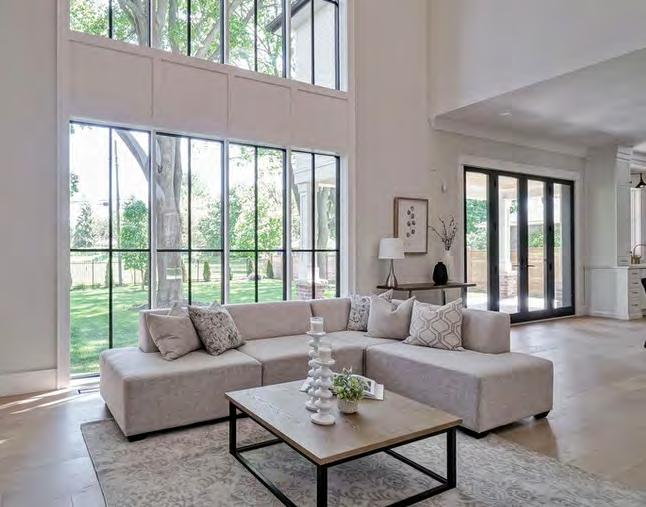






Offered in multiple shades, the Google Nest (Wired, 2nd-Gen) was recently ranked as the No. 1 smart doorbell by the New York Times

Providing a wide view, the ecobee Smart Doorbell Camera's radar and motion detection features help cut down on false alarms.

hub. This security camera would compete with offerings from Amazon, Google and others. With the cameras utilizing cloud backups, Apple’s push into home security will promote new iCloud subscriptions.
While still in early development, these products could offer serious competition to established players like Amazon Ring and Google Nest, particularly with Apple’s emphasis on security and privacy.
The Ring Wired Doorbell Pro 2 video doorbell features facial recognition, ensuring you see everything clearly, from the visitor’s face to the packages
on the ground. This model includes 3D Motion Detection and Bird’s Eye View technology, allowing precise tracking of movements around your property with the ability to customize alert zones for increased accuracy. It’s integrated with Alexa (since it’s owned by Amazon) through the Ring Protect Plan, although several features require a separate ongoing subscription.
Ranked as the best smart doorbell camera by The New York Times’ Wirecutter, the newest Google Nest Doorbell facial recognition uses built-in intelligence to distinguish between people, packages, animals and vehicles, enhancing the precision
of security alerts. The doorbell, which requires the Google Home app, can be installed wire-free or wired, and supports HD video, including night vision. Able to store up to an hour of video during internet or power outages, it integrates seamlessly with Google Nest and Amazon smart-home ecosystems for real-time interactions and alerts.
ecobee Smart Doorbell Camera
The ecobee Smart Doorbell Camera’s facial recognition offers 1080p imaging and an expansive 175° vertical and 187° diagonal field of view to view a visitor from head to toe. Advanced radar and motion detection features minimize false alarms by precisely identifying people and packages. OHB










FOUNDED: 1991 MEMBERS: 63
OHB: So it’s 31 years for you as EO at HCHBA. How’d it all start?
Aggie Tose: “I was hired by Gary Burtch (G.J. Burtch Construction) in 1993. I thought it was part-time, but my mother warned me that Gary would have me doing a lot more. She was right. It was more like 45 hours a week. Gary was EO of Haliburton County HBA at the time and was gradually putting more and more association stuff on my desk, and eventually said to the executive, ‘You know, I’m not really doing this anymore—Aggie’s doing it.’”
You’re a staff of one, but you’re everywhere for OHBA events. What’s your annual mileage?
“It would be too scary to calculate. I attend other locals’ events, national and provincial conferences, national board meetings, EO meetings, workingfrom-heights and other training events locally... I’d ballpark around 460 functions this year, with maybe 100 outside Haliburton.”
You’ve made huge inroads with local schools in the past year. “We doubled up on our work with the high schools and elementary schools, partnering with the County Council. I was able to get almost $8,000 for school materials and tools from them, which was about what Haliburton County HBA had spent out of our own
pockets in 2023. Then, in November, we learned that the high school’s half-century-old planer was regularly down, so we bought them a new $10,000 planer and got it installed over Christmas by one of our members. The kids have been just tickled working away with it.
“We are also preparing for our third annual bus tour on May 28. We’ll be picking up the kids at school and taking them to a municipal office and building department, showing them the process from where the permit comes in, how it goes through the system and what happens afterward with inspectors and the contractors. Our next stop is Thomas Contracting, a huge plant whose services including milling stone and sand. Then down the highway is Kegel Heating & Cooling, where they manufacture their own tin work. And then we’ll finish off the bus tour at one of our top sponsors, Ridgewood Ford, to see how their mechanic shop operates.
“We’re trying to show the kids that it’s not all hammers and nails. Many of our members need licensed mechanics, people in the office, computer-aided design experts, etc.”
What are your proudest achievements as an HBA?
“One that sticks out, and it’s where we picked up several new sponsors and members, was our united stand a year

and a half ago when the county tried to push through a shoreline bylaw that would have shut down everything from landscaping to building. We were able to bring them back to a more workable agreement. We even had input from one of our members’ friends—a researcher in New Zealand. Their biggest issue was water protection and soil retention. That’s obviously very important to us too, but they were requesting far beyond what we believed to be necessary, and it would only apply to new projects. Existing owners whose lawns ran right down to the water would not have had to adjust their waterfronts! The county was also concerned that our work would trigger algae blooms, even though we’ve never had them in this region. We brought common sense to our presentation, including newspaper ads, and held community meetings. We even had non-members from way up in Dorset, who would also have been affected, attend the meetings.”
events suggest that Haliburton County holds your HBA in high esteem.
“Our president, Tom Neville, accepted the Warden’s Award on our behalf in October. It acknowledges work and commitment to the community and is the second-highest award that the Haliburton Chamber of Commerce bestows. We are truly honoured by it.”
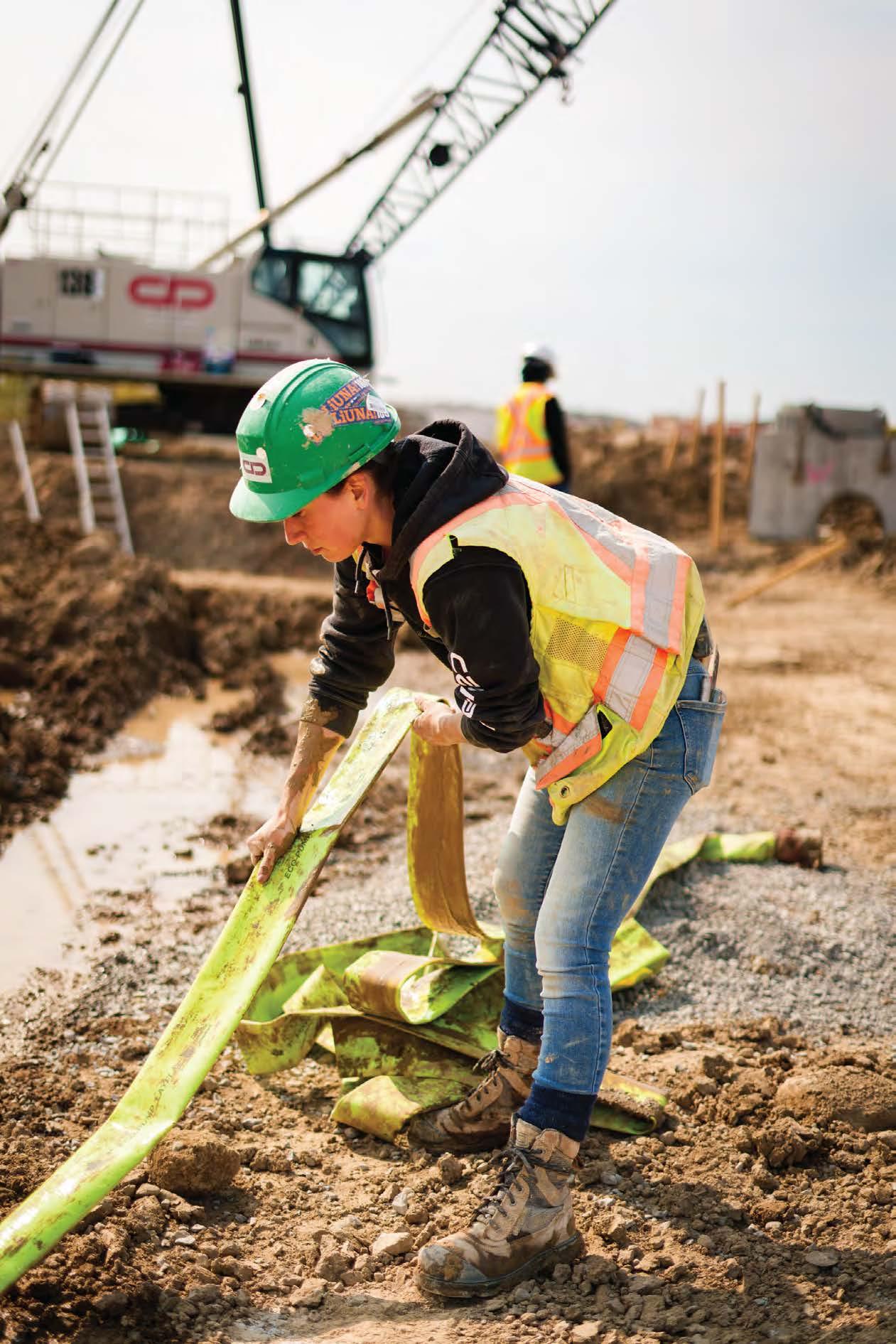





















































INN OVA TION BU ILT B ETTE R

At Napoleon®, our systems are optimized for R410A refrigerant, ensuring outstanding performance in every season —whether cooling in summer or staying warm during the harshest Canadian winters. With unmatched reliability and efficiency, Napoleon keeps your home comfortable while supporting sustainability.
Proven Reliability
Superior Efficiency
Zero Ozone Depletion Potential (ODP)

DISCOVER THE POWER OF R410A WITH NAPOLEON